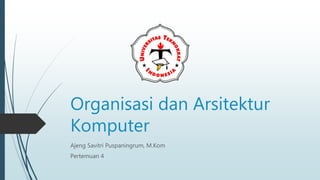
Computer Evolution and Performance (part 2)
- 1. Organisasi dan Arsitektur Komputer Ajeng Savitri Puspaningrum, M.Kom Pertemuan 4
- 2. Computer Evolution and Performance (part 2)
- 3. Learning Objective To learn Moore’s Law To learn CPU’s generation
- 4. Generations of Computer Vacuum tube - 1946-1957 Transistor - 1958-1964 Small scale integration - 1965 on Up to 100 devices on a chip Medium scale integration - to 1971 100-3,000 devices on a chip Large scale integration - 1971-1977 3,000 - 100,000 devices on a chip Very large scale integration - 1978 -1991 100,000 - 100,000,000 devices on a chip Ultra large scale integration – 1991 - Over 100,000,000 devices on a chip
- 5. von Neumann/Turing Stored Program concept Main memory storing programs and data ALU operating on binary data Control unit interpreting instructions from memory and executing Input and output equipment operated by control unit Princeton Institute for Advanced Studies IAS Completed 1952
- 6. Structure of von Neumann Machine
- 7. IAS - details 1000 x 40 bit words Binary number 2 x 20 bit instructions Set of registers (storage in CPU) Memory Buffer Register Memory Address Register Instruction Register Instruction Buffer Register Program Counter Accumulator Multiplier Quotient
- 8. Structure of IAS – detail
- 9. Moore’s Law Increased density of components on chip Gordon Moore – co-founder of Intel Number of transistors on a chip will double every year Since 1970’s development has slowed a little Number of transistors doubles every 18 months Cost of a chip has remained almost unchanged Higher packing density means shorter electrical paths, giving higher performance Smaller size gives increased flexibility Reduced power and cooling requirements Fewer interconnections increases reliability
- 10. Growth in CPU Transistor Count
- 11. IBM 360 series 1964 Replaced (& not compatible with) 7000 series First planned “family” of computers Similar or identical instruction sets Similar or identical O/S Increasing speed Increasing number of I/O ports (i.e. more terminals) Increased memory size Increased cost Multiplexed switch structure
- 12. DEC PDP-8 1964 First minicomputer (after miniskirt!) Did not need air conditioned room Small enough to sit on a lab bench $16,000 $100k+ for IBM 360 Embedded applications & OEM BUS STRUCTURE
- 13. DEC - PDP-8 Bus Structure
- 14. Semiconductor Memory 1970 Fairchild Size of a single core i.e. 1 bit of magnetic core storage Holds 256 bits Non-destructive read Much faster than core Capacity approximately doubles each year
- 15. Intel 1971 - 4004 First microprocessor All CPU components on a single chip 4 bit Followed in 1972 by 8008 8 bit Both designed for specific applications 1974 - 8080 Intel’s first general purpose microprocessor
- 16. Speeding it up Pipelining On board cache On board L1 & L2 cache Branch prediction Data flow analysis Speculative execution
- 17. Performance Balance Processor speed increased Memory capacity increased Memory speed lags behind processor speed
- 18. Login and Memory Performance Gap
- 19. Solutions Increase number of bits retrieved at one time Make DRAM “wider” rather than “deeper” Change DRAM interface Cache Reduce frequency of memory access More complex cache and cache on chip Increase interconnection bandwidth High speed buses Hierarchy of buses
- 20. I/O Devices Peripherals with intensive I/O demands Large data throughput demands Processors can handle this Problem moving data Solutions: Caching Buffering Higher-speed interconnection buses More elaborate bus structures Multiple-processor configurations
- 21. Typical I/O Device Data Rates
- 22. Key is Balance Processor components Main memory I/O devices Interconnection structures
- 23. Improvements in Chip Organization and Architecture Increase hardware speed of processor Fundamentally due to shrinking logic gate size More gates, packed more tightly, increasing clock rate Propagation time for signals reduced Increase size and speed of caches Dedicating part of processor chip Cache access times drop significantly Change processor organization and architecture Increase effective speed of execution Parallelism
- 24. New Approach – Multiple Cores Multiple processors on single chip Large shared cache Within a processor, increase in performance proportional to square root of increase in complexity If software can use multiple processors, doubling number of processors almost doubles performance So, use two simpler processors on the chip rather than one more complex processor With two processors, larger caches are justified Power consumption of memory logic less than processing logic
- 25. x86 Evolution (1) 8080 first general purpose microprocessor 8 bit data path Used in first personal computer – Altair 8086 – 5MHz – 29,000 transistors much more powerful 16 bit instruction cache, prefetch few instructions 8088 (8 bit external bus) used in first IBM PC 80286 16 Mbyte memory addressable up from 1Mb 80386 32 bit Support for multitasking 80486 sophisticated powerful cache and instruction pipelining built in maths co-processor
- 26. x86 Evolution (2) Pentium Superscalar Multiple instructions executed in parallel Pentium Pro Increased superscalar organization Aggressive register renaming branch prediction data flow analysis speculative execution Pentium II MMX technology graphics, video & audio processing Pentium III Additional floating point instructions for 3D graphics
- 27. x86 Evolution (3) Pentium 4 Note Arabic rather than Roman numerals Further floating point and multimedia enhancements Core First x86 with dual core Core 2 64 bit architecture Core 2 Quad – 3GHz – 820 million transistors Four processors on chip x86 architecture dominant outside embedded systems Organization and technology changed dramatically Instruction set architecture evolved with backwards compatibility ~1 instruction per month added 500 instructions available See Intel web pages for detailed information on processors
- 28. Refference Stalling, William, Computer Organization and Architecture, 10th Edition, Pearson, 2015 Abdurohman, Maman, Organisasi dan Arsitektur Komputer revisi ke-4, Penerbit Informatika, 2017
